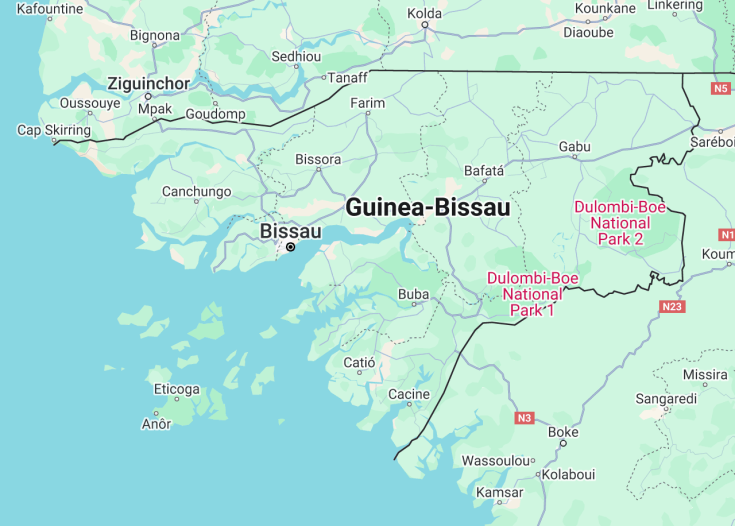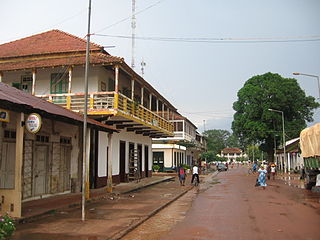Located on the western coast of Africa, Guinea-Bissau is a hidden gem waiting to be explored. With its rich cultural heritage and abundant natural beauty, this small country offers a unique and authentic travel experience. From exploring the historic capital city of Bissau to relaxing on the pristine beaches of the Bijagos Archipelago, there is something for everyone to enjoy in Guinea-Bissau. Discover the vibrant markets, sample traditional cuisine, and immerse yourself in the warm hospitality of the local people. Experience the untouched beauty of this African nation and create memories that will last a lifetime.
Go off the beaten path and explore the remote islands of the Bijagos Archipelago.
Savor the delicious flavors of Guinea-Bissau’s traditional cuisine, including spicy jollof rice and fresh seafood dishes.
Guinea-Bissau: the hidden gem of West Africa
| Capital | Bissau |
| Time in Guinea-Bissau | GMT |
| Language spoken | Portuguese |
| Population | 1.9 million (source: World Bank, 2021) |
| Religion | Islam (45%) Christianity (31%) Traditional African religions (22%) Others (2%) |
| Currency | West African CFA franc (Fr, XOF) |
| Airports | Osvaldo Vieira International Airport |
Guinea-Bissau, a relatively lesser-known treasure in West Africa, is an enticing blend of rich history, diverse cultures, and untouched natural beauty. With a landscape dominated by the tranquil Bijagós archipelago, it stands as a testament to nature’s majesty. The islands, many of which are UNESCO Biosphere Reserves, host a myriad of wildlife and are characterized by their pristine beaches and mangroves.
The nation’s history, marked by its indigenous kingdoms and subsequent Portuguese colonization, resonates in the architectural remnants of Bolama, its former capital. Independence in 1973, after a protracted struggle, was a turning point, forging a new identity for the country. Yet, through these changes, the vibrant tapestry of its local tribes and traditions has been lovingly preserved, offering a genuine experience for travelers.
Visitors to Guinea-Bissau will be captivated not only by its natural beauty but also by its cultural celebrations. The Carnaval in Bissau, the capital city, is a spectacle of dance, music, and colorful costumes. Equally compelling is the nation’s musical landscape, deeply influenced by both its African roots and Portuguese heritage.
Where is Guinea-Bissau located?
Guinea-Bissau is nestled in West Africa, bordered by Senegal to the north and Guinea to the south and east, while its western side is flanked by the Atlantic Ocean.
What is Guinea-Bissau famous for?
Guinea-Bissau is best known for its biodiverse Bijagós archipelago, its vibrant Carnaval celebrations, and as a harmonious melting pot of African and Portuguese cultures and traditions.
History
Prehistoric Times: Origins of Inhabitance
The earliest traces of human settlement in Guinea-Bissau come from archaeological findings, suggesting that the region has been inhabited for thousands of years. These initial communities were primarily hunter-gatherers, evolving over time and engaging in basic agriculture and trade.
11th-15th Century: Influence of the Great African Kingdoms
Guinea-Bissau’s history was profoundly influenced by the rise and fall of great West African empires. The Mali Empire, in particular, extended its influence to the region, bringing with it the spread of trade and Islam. The cultural and economic impacts of these empires left an indelible mark on the fabric of Guinea-Bissau’s society.
15th Century: European Exploration
The mid-15th century marked a significant turning point with the arrival of Portuguese explorers. They were attracted to the region’s potential for trade, especially in slaves and gold. Over time, Guinea-Bissau became a hub in the transatlantic slave trade, with European powers establishing coastal trading posts to facilitate the inhumane business.
16th-19th Century: Portuguese Colonial Rule
The Portuguese gradually expanded their control over the region, establishing Guinea-Bissau as a colony by the late 19th century. The local populace faced exploitation under the colonial regime, being subjected to forced labor and enduring socio-economic inequalities. The cashew nut, introduced by the Portuguese, became a significant export crop and remains crucial for the country’s economy to this day.
20th Century: Fight for Independence
The mid-20th century was a period of awakening, with nationalist movements demanding independence from colonial rule. The African Party for the Independence of Guinea and Cape Verde (PAIGC), led by Amílcar Cabral, played a central role in this struggle. After a prolonged guerrilla war and international pressure, Guinea-Bissau declared its independence in 1973, and it was officially recognized by Portugal in 1974.
1974-1990s: Post-Independence Turmoil
Following independence, the country faced a series of challenges. The intended unity between Guinea-Bissau and Cape Verde, both former Portuguese colonies, fell apart. Political instability was rampant, with several coups and political assassinations marking the era. The country’s economy also struggled, and development was slow.
21st Century: A Struggle for Stability
The new millennium did not immediately bring the desired stability to Guinea-Bissau. The early 2000s witnessed repeated military coups, political assassinations, and frequent changes in leadership. However, amidst these challenges, there have been attempts to establish a stable democratic process. International organizations, including the United Nations and African Union, have been involved in efforts to restore and maintain peace in the country.
Visit Guinea-Bissau
What to see and do in Guinea-Bissau.
When visiting Guinea-Bissau, there are several attractions and activities that should not be missed:
- Explore the capital city of Bissau, with its colonial-era architecture and vibrant markets.
- Visit the Bijagós Islands, a UNESCO Biosphere Reserve known for their pristine beaches, rich biodiversity, and traditional communities.
- Experience the unique cultures and traditions of the ethnic groups in Guinea-Bissau, such as the Balanta, Fula, and Mandinka.
- Explore the Orango Islands National Park, home to diverse wildlife including hippos, turtles, and various bird species.
- Discover the Cacheu Historic Center, a well-preserved colonial town with its fortress and historical landmarks.
These are just a few of the highlights that Guinea-Bissau has to offer. The country’s natural beauty, cultural richness, and historical significance make it a truly unique destination.
Events in Guinea-Bissau
Throughout the year, Guinea-Bissau hosts a range of events and celebrations that showcase its cultural traditions and heritage. Some of the notable events include:
- The Independence Day celebration on September 24th, marking the country’s independence from Portuguese colonial rule.
- The Tabanca Festival, held in various villages, featuring traditional music, dance, and ceremonies.
- The Cashew Nut Festival, celebrating the importance of cashew nuts to the country’s economy and culture.
These events provide visitors with an opportunity to immerse themselves in the vibrant culture of Guinea-Bissau and witness traditional practices passed down through generations.
Best time to visit Guinea-Bissau
The best time to visit Guinea-Bissau is during the dry season, which lasts from November to May. This period offers pleasant weather with lower humidity and minimal rainfall, making it ideal for outdoor activities and exploration. The rainy season, from June to October, brings heavy downpours and increased humidity, which can hinder travel and outdoor adventures.
Visitors should note that the Bijagós Islands may have a slightly different climate pattern, with the dry season typically starting later and lasting until June.
It’s also worth considering the timing of specific events and festivals, such as the Tabanca Festival or the Cashew Nut Festival, which can add an extra layer of cultural immersion to your trip.
Is Guinea-Bissau worth visiting?
Guinea-Bissau is a destination that offers a unique blend of natural beauty, cultural diversity, and historical significance. While it may not be as well-known as other tourist destinations, it offers a truly authentic and off-the-beaten-path experience for adventurous travelers.
From the vibrant markets of Bissau to the untouched beaches of the Bijagós Islands, Guinea-Bissau has a lot to offer. The country’s rich history, from its pre-colonial roots to its struggle for independence, provides an important backdrop for visitors to understand and appreciate its unique culture.
However, it’s important to note that Guinea-Bissau is still a developing nation facing various challenges. Infrastructure, services, and amenities may not be on par with more established tourist destinations. Travelers should be prepared for a more rustic and adventurous experience.
For those seeking an authentic, culturally immersive experience and a desire to explore untamed natural beauty, Guinea-Bissau is definitely worth considering. However, it may not be the best choice for those seeking luxury or well-developed tourist infrastructure.













